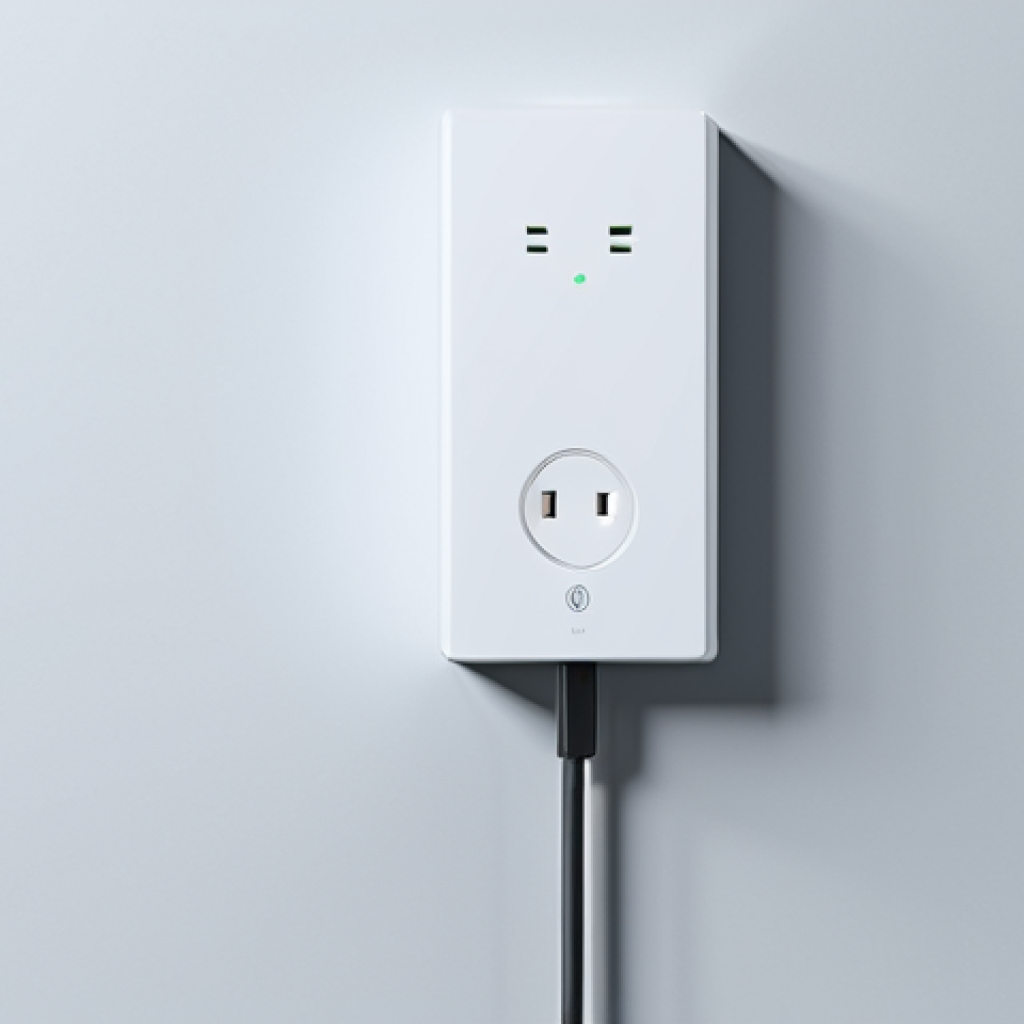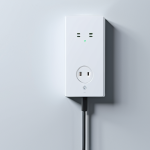There’s nothing quite like that heart-sinking moment when your phone battery plummets into the red, miles from the nearest outlet, or worse, mid-conversation.
We’ve all been there, frantically searching for a charger, only to realize the cable is tangled, lost, or just plain incompatible. But what if that anxiety became a relic of the past?
What if power was always just, well, *there*? The truth is, portable wireless power devices aren’t just a futuristic fantasy anymore; they’re rapidly becoming an indispensable part of our daily lives, liberating us from the tyranny of cables and brick-and-mortar power sockets.
Imagine powering your devices effortlessly, whether you’re camping under the stars or presenting in a bustling conference room. It’s truly a game-changer, but like any nascent technology, it’s evolving at a breathtaking pace, bringing new solutions alongside new questions.
From the early days of clunky charging pads, we’re now seeing sleek, multi-device chargers, and even emerging long-distance solutions that promise to wirelessly power gadgets across a room.
I personally find it incredibly liberating, especially when I’m traveling or rushing between meetings – no more forgotten cables or hunting for a spare outlet at the airport.
It’s not just about convenience; it’s about a fundamental shift in how we interact with our tech. However, this isn’t without its growing pains; efficiency, heat management, and universal compatibility remain significant hurdles.
My biggest gripe, honestly, has been the charging speed on some earlier models, but even that’s rapidly improving, with companies pushing boundaries on power delivery.
The buzz online is all about the next wave: devices that charge seamlessly in your pocket, or even ambient power fields integrated into public spaces, making “low battery” alerts a thing of the past.
Think smart cities where your smartwatch perpetually sips power from the air, or outdoor adventures where your drone recharges mid-flight. The future also holds fascinating implications for disaster relief and off-grid living, potentially revolutionizing access to power in remote areas.
While we’re not quite there yet with true long-range, high-power wireless transmission, the research and development are incredibly exciting, hinting at a world where power is as ubiquitous as Wi-Fi.
Let’s dive deeper and uncover what’s truly possible.
The Untethered Revolution: Why We’re Ditching the Cables

There was a time, not so long ago, when the thought of charging your phone without plugging it in felt like something out of a sci-fi movie. I still remember the sheer amazement I felt the first time I set my new smartphone on a wireless charging pad – it was almost magical. No more fumbling in the dark for the tiny charging port, no more frayed cables, and certainly no more arguments over who left the charger plugged in where. This isn’t just about convenience; it’s a fundamental re-imagining of our relationship with power. We’re moving from a world of restrictive tethers to one where energy is seamlessly accessible, integrated into our environments, and always ready when we need it. This shift is deeply personal for me because, like many, my life is a whirlwind of devices, and the constant need to find an outlet was genuinely stressful. I’ve always been an early adopter, and seeing this technology mature from a quirky novelty into an indispensable tool has been fascinating. It’s truly liberating to pack for a trip and only worry about the devices, not a tangled mess of proprietary chargers and adapters. The subtle hum of a device charging on a sleek pad, rather than the clunk of a cable, brings a certain peace of mind that once seemed unattainable. It changes daily habits, allowing for a more fluid interaction with our gadgets, always ready for the next task or spontaneous adventure. This isn’t just about a single device; it’s about an ecosystem of power that supports our increasingly connected lives.
From Concept to Everyday: A Rapid Evolution
The journey of wireless power, or inductive charging as it was first widely known, has been incredibly swift. What began as a niche feature on a few high-end smartphones has rapidly permeated almost every aspect of our tech lives. I vividly recall the early days when you had to perfectly align your device on a tiny sweet spot, and the charging speed was, frankly, abysmal. It felt more like a parlor trick than a practical solution. But manufacturers didn’t give up. They pushed the boundaries, refining the coils, improving efficiency, and expanding the charging zones. Now, we have multi-device charging pads that can power your phone, smartwatch, and earbuds all at once, often with magnetic alignment for a satisfying click and optimal charge. This evolution speaks volumes about the demand for seamless power delivery and the rapid pace of innovation. It’s gone from a luxury to an expectation, especially as our lives become increasingly digital and the number of devices we carry multiplies. The convenience factor alone is enough for many, but the real magic is how it simplifies our environments, reducing clutter and making our desks and nightstands look significantly tidier. My own home has been transformed, with a charging pad on almost every surface where a device might rest, making charging an almost subconscious act.
The Unexpected Perks of Going Cord-Free
Beyond the obvious convenience, stepping into the world of wireless power brings a host of unexpected benefits that you only truly appreciate once you’ve experienced them. For one, it dramatically reduces wear and tear on your device’s charging port. How many times have you had a cable that just wouldn’t stay in, or a port that became loose and unreliable? That’s largely a thing of the past with wireless charging. I’ve personally saved a small fortune on replacement cables and repair costs for damaged ports. Secondly, it fosters a cleaner, more minimalist aesthetic. Wires are inherently messy, and eliminating them from your primary charging spots creates a sense of order and calm. It’s surprising how much visual clutter even a few charging cables can create. Thirdly, and perhaps most importantly, it makes “topping off” your battery an effortless habit. Instead of deliberately finding a cable and plugging in, you simply place your device down when not in use. This leads to devices that are almost always sufficiently charged, reducing battery anxiety and ensuring you’re ready for whatever the day throws at you. For someone who relies heavily on their devices for work and personal life, this continuous readiness is invaluable.
Beyond the Pad: Exploring Diverse Wireless Charging Technologies
When most people hear “wireless charging,” they immediately picture a flat pad. And while that’s certainly the most common form, the world of untethered power is far more diverse and exciting than just inductive mats. Engineers and researchers are pushing the boundaries of physics to find new ways to deliver power without a physical connection, leading to innovative solutions for different scenarios. From resonant charging that can power devices over greater distances to true long-range solutions that are still in their infancy, the technological landscape is rapidly expanding. I’ve been fascinated watching these different technologies emerge, each with its own set of advantages and limitations, tailored for specific use cases. It’s not a “one size fits all” scenario, and understanding the nuances of each can help you appreciate the incredible complexity and ingenuity behind this revolution. The differences in how these technologies transmit power, their efficiency, and their range dictate where and how they can be effectively deployed, opening up possibilities that were once unthinkable.
Inductive Charging: The Ubiquitous Standard
This is the workhorse of the wireless charging world, the technology that powers most smartphones and smartwatches today. Based on the principle of electromagnetic induction, it uses two coils – one in the charging pad and one in the device – to transfer energy when they are in close proximity. The most widely adopted standard is Qi (pronounced “chee”), which has become almost synonymous with wireless charging. I remember buying one of the first Qi pads years ago, and while it was finicky, it showed immense promise. Now, Qi pads are everywhere: built into furniture, car consoles, and even public spaces like coffee shops. The beauty of Qi is its simplicity and relative efficiency for short-range power transfer. It’s ideal for static charging, where you place a device down and leave it for a while, like on a nightstand or desk. While it requires direct contact or very close proximity, its reliability and widespread adoption make it incredibly convenient. The latest iterations of Qi are also boasting faster charging speeds, approaching those of wired connections, which addresses one of my earlier frustrations with the technology. It’s a testament to how far this foundational tech has come.
Resonant Charging: Powering from a Distance
While inductive charging needs close contact, resonant charging, often seen with standards like Wi-Charge or Ossia’s Cota, offers the exciting possibility of charging devices from a few inches or even several feet away. This technology uses magnetic resonance to transfer energy between coils tuned to the same frequency. Imagine a transmitter that could charge your laptop or smart speaker from across the room, or even power multiple devices simultaneously without them sitting on a pad. I’ve seen demos of this, and it feels genuinely futuristic. It’s still less common in consumer products than inductive charging, primarily due to cost, efficiency at longer distances, and regulatory hurdles concerning power transmission over air. However, its potential is enormous, especially for applications where devices need to be charged while in use or constantly topped up without user intervention. Think about smart home devices, IoT sensors, or even medical implants that could perpetually draw power without ever needing a battery replacement. The implications for smart environments and truly always-on devices are profound, pushing us closer to a world where power is truly “ambient.”
The Emerging Frontier: RF and Laser Power Delivery
Beyond inductive and resonant methods, researchers are actively exploring even more ambitious forms of wireless power, including radio frequency (RF) and laser-based power delivery. RF charging converts ambient radio waves (like Wi-Fi or cellular signals) into usable energy, offering micro-power for very low-power devices like small sensors or wearables, potentially making them battery-free. I’ve read about research into “power over Wi-Fi” and it’s incredibly cool, imagining a future where passive sensors never need charging. Laser power delivery, on the other hand, uses focused beams of light to transmit significant amounts of power over long distances, potentially for drones, remote equipment, or even electric vehicles. While this technology is still largely in the lab due to safety concerns and efficiency challenges, its long-range, high-power potential is undeniable. These are the cutting edge, the technologies that will likely define the next decade of wireless power, moving us closer to a truly boundless energy landscape.
Everyday Impact: Where Wireless Power Truly Transforms Lives
It’s one thing to talk about technology in abstract terms, but the real magic of portable wireless power devices becomes apparent when you see how they integrate into and simplify our daily lives. From the mundane morning routine to unexpected emergencies, these devices are quietly revolutionizing how we interact with our electronics. I’ve found them to be truly indispensable in scenarios I hadn’t even considered when I first started using them. They’re not just gadgets; they’re enablers, allowing us to be more flexible, productive, and less burdened by the constant search for an outlet. The shift is subtle but profound, akin to how Wi-Fi changed our relationship with internet access – suddenly, it was just *there*. This omnipresence of power is what truly excites me, as it opens up so many possibilities for how we live, work, and play.
Decluttering and Streamlining Your Home and Office
If you’re anything like me, your home and office used to be a tangled mess of charging cables, each for a different device, often lost or mixed up. Wireless charging has, for me, been a godsend in decluttering these spaces. I’ve replaced multiple individual chargers with sleek, multi-device charging pads that sit unobtrusively on my nightstand, desk, and kitchen counter. My phone, smartwatch, and earbuds all charge simultaneously, neatly tucked away without a single visible cable. This isn’t just about aesthetics; it’s about mental clarity. A tidy space leads to a tidier mind, and not having to dig for the right cable when you need a quick charge is surprisingly liberating. It makes daily routines smoother and less frustrating, transforming charging from a chore into a seamless part of putting your device down. I’ve also noticed a significant reduction in cable wear and tear, meaning less money spent on replacements.
Empowering On-the-Go Lifestyles and Travel
For the frequent traveler or anyone with a busy, on-the-go lifestyle, portable wireless power is an absolute game-changer. I used to pack a separate charger for my phone, my earbuds, my tablet, and sometimes even a portable battery pack, resulting in a confusing jumble of cables in my bag. Now, I often just bring a single wireless power bank that can charge all my Qi-compatible devices. Imagine being at the airport, waiting for a flight, and being able to top up your phone simply by placing it on your power bank in your lap, without searching for a free outlet. Or camping in the wilderness, knowing your essential devices can be charged effortlessly. I recently took a road trip, and having a wireless charging pad in the car was incredibly convenient – my co-pilot could place their phone down, and it would charge without needing to find a specific cable or adapter. This freedom from outlets and cables allows for greater spontaneity and less travel anxiety, which for me, is priceless.
Beyond Personal Devices: Public and Commercial Applications
While personal convenience is a major driver, the broader implications of wireless power extend far beyond our individual gadgets. We’re starting to see wireless charging integrated into public spaces: coffee shop tables, airport lounges, and even public transportation. This makes charging accessible to everyone, reducing the reliance on limited outlets. In commercial settings, it’s transforming industries. Imagine warehouses where automated guided vehicles (AGVs) can charge wirelessly during their routes, or retail environments where display models are always powered without visible cords. Hospitals could benefit from wirelessly charged medical devices, improving hygiene and safety. For me, seeing a wireless charging spot at my local cafe was a moment of “we’ve truly arrived.” It’s not just about charging our personal devices; it’s about building an infrastructure where power is as ubiquitous and unobtrusive as Wi-Fi, fostering smarter, more efficient environments for everyone.
Navigating the Hurdles: Understanding Wireless Power Limitations
While the allure of a cord-free world is undeniable, it’s crucial to acknowledge that portable wireless power, like any evolving technology, isn’t without its challenges and limitations. My journey with these devices has certainly had its share of minor frustrations, especially in the early days. Understanding these constraints is not about dimming the enthusiasm, but rather about setting realistic expectations and appreciating the ongoing efforts to overcome them. These aren’t insurmountable problems, but rather areas of active research and development that will continue to improve as the technology matures. It’s easy to get caught up in the futuristic vision, but a practical understanding of current realities is essential for making informed choices and managing expectations.
Efficiency and Heat Generation Concerns
One of the primary challenges of wireless charging, particularly inductive charging, is energy efficiency. When power is transferred wirelessly, some energy is inevitably lost as heat during the conversion process. This means a wireless charger is typically less efficient than a direct wired connection. For instance, while a wired charger might deliver 95-98% of the power from the outlet to your device, a wireless charger might be closer to 70-80%. While this isn’t a massive issue for a single phone charge, it does mean a slightly higher energy consumption over time, and it generates more heat, both in the charger and the device. I’ve definitely noticed my phone getting warmer on some wireless pads, particularly during fast charging. Excessive heat can potentially impact battery longevity over the long term, although most modern devices have safeguards to prevent overheating. Manufacturers are constantly working on improving coil designs and thermal management to minimize these losses, but it remains an area of ongoing optimization.
Charging Speed and Distance Limitations
Another significant limitation, especially compared to the fastest wired charging solutions, has been charging speed. Early wireless chargers were noticeably slower, making them suitable only for overnight charging. While recent advancements, particularly with enhanced Qi standards and proprietary fast wireless charging technologies, have significantly closed this gap – some now offering up to 15W or even 20W – they still often lag behind the super-fast wired chargers that can deliver 60W or more. This means if you need a rapid top-up before heading out, a cable might still be your go-to. Furthermore, the distance limitation is inherent in most currently widespread wireless charging technologies. Inductive charging requires very close proximity, often direct contact. While resonant charging can extend this to a few feet, true “charge-across-the-room” power for high-power devices is still largely experimental due to efficiency loss over distance and safety regulations. My personal frustration often stems from devices not being perfectly aligned, leading to slower charging or no charge at all – a small but frequent annoyance.
Compatibility and Universal Standards
Despite the widespread adoption of the Qi standard, compatibility can still be a minor headache. While most major smartphone brands support Qi, there are variations in coil placement, charging speeds, and proprietary fast wireless charging protocols that might not work perfectly across all chargers. For instance, an iPhone will charge on most Qi pads, but might only achieve its fastest wireless charging speed on an Apple MagSafe charger or a certified MagSafe accessory. Similarly, some Android phones have specific requirements for their fastest wireless charging. This means that while universal baseline charging is common, achieving optimal performance often requires specific charger-device pairings. This fragmented ecosystem can be a bit confusing for consumers trying to find the “best” charger for their particular device, leading to a trial-and-error approach for some. I’ve ended up with a collection of wireless chargers, each best suited for a particular device or scenario, which somewhat negates the “simplicity” aspect.
The Future is Untethered: What’s Next in Wireless Power
Peering into the crystal ball, the future of wireless power is incredibly exciting and holds the promise of fundamentally changing our relationship with energy. It’s not just about charging our phones anymore; it’s about creating an ambient power environment where our devices are perpetually powered, seamlessly and invisibly. The research and development in this field are moving at a breathtaking pace, with breakthroughs emerging regularly that push the boundaries of what we thought was possible. My imagination runs wild when I think about how these innovations will reshape not just our personal tech, but also smart infrastructure, industrial applications, and even how we respond to global challenges. We’re on the cusp of truly liberating ourselves from the grid, in ways that extend far beyond simply eliminating cables.
Ambient Power and “Charge-and-Forget” Ecosystems
The ultimate vision for wireless power is an “ambient” environment where devices are constantly and silently drawing power from the air, much like they connect to Wi-Fi. Imagine a smart home where your smart speakers, thermostats, and sensors never need batteries or a charge. They’re simply powered by an invisible energy field emanating from discreet transmitters in your walls or ceilings. This “charge-and-forget” paradigm would eliminate battery anxiety entirely for a vast array of devices, enabling truly always-on IoT ecosystems. I’ve read about companies developing systems that can power low-energy devices using rectified radio frequency (RF) signals, essentially repurposing stray energy from Wi-Fi routers. While the power output is currently very low, suitable for only the smallest sensors, it paints a compelling picture of a future where devices are truly energy-independent, perpetually sipping power from their surroundings. This would have massive implications for device design, making products smaller, lighter, and more environmentally friendly by reducing battery waste.
Long-Range and High-Power Wireless Transmission
While resonant charging extends the range to a few feet, the holy grail is truly long-range, high-power wireless transmission. Imagine walking into your living room and your laptop, tablet, and phone all begin charging without being placed on a mat or even in the same room as a dedicated charger. Companies like Powercast are already creating solutions that can deliver small amounts of power to devices several meters away using directed RF energy, primarily for low-power industrial sensors or small wearables. More ambitious projects involve using focused millimeter-wave beams or even infrared lasers to transmit significant power over tens or even hundreds of meters, potentially powering drones mid-flight or electric vehicles parked in a garage. These technologies face significant regulatory and safety hurdles, but the potential is transformative, enabling truly mobile charging that doesn’t require proximity to a power source. The day I can put my drone away without plugging it in, knowing it’s perpetually topped up by an ambient field, will be a game-changer for my hobbies.
The Green Implications and Societal Impact
Beyond convenience, the widespread adoption of efficient wireless power has significant environmental and societal implications. Firstly, it could drastically reduce electronic waste by minimizing the need for replacement cables and potentially extending the lifespan of devices by reducing port damage. Secondly, it could enable the deployment of countless battery-free sensors and IoT devices, leading to smarter, more efficient cities and industries. Thirdly, and perhaps most profoundly, it could revolutionize power access in remote or underserved areas. Imagine off-grid communities where essential medical devices or communication tools can be powered from a central wireless energy source, circumventing the need for expensive and often unreliable grid infrastructure. The ability to deliver power flexibly and without physical connections opens doors for humanitarian aid, disaster relief, and sustainable development. I truly believe that as this technology matures, its impact will extend far beyond consumer electronics, touching critical areas of our global infrastructure and environmental efforts.
Choosing Your Untethered Power Solution: A Practical Guide
With so many options now available, choosing the right portable wireless power device can feel a bit overwhelming. It’s not just about picking the first one you see; it’s about understanding your needs, device compatibility, and the specific features that will make the biggest difference in your daily life. I’ve tried numerous models, from budget-friendly pads to premium multi-device stands, and I’ve learned that the “best” solution is always the one that fits your personal usage patterns and budget. Don’t be swayed by marketing hype; focus on what truly matters for how you live and work. Think about where you charge most often, how many devices you need to power simultaneously, and what your priorities are in terms of speed and portability.
Identifying Your Core Charging Needs
Before you even start looking at specific models, take a moment to assess your primary charging habits. Are you mostly charging your phone overnight on a nightstand? Then a simple, reliable single-device charging pad might be perfect. Do you need to charge your phone, smartwatch, and earbuds all at once on your desk? A 3-in-1 stand or mat would be a better fit. Are you constantly on the move and need to top up your devices throughout the day? A portable wireless power bank is your answer. Consider the types of devices you own – are they all Qi-compatible? Do they support fast wireless charging? Understanding these fundamental needs will narrow down your options significantly and prevent you from overspending on features you don’t need or getting something that doesn’t quite meet your demands. I personally prioritized a multi-device charger for my desk, as that’s where most of my gadgets congregate during the day.
Key Features and Specifications to Look For
Once you’ve identified your needs, it’s time to dive into the specs. Here’s a quick rundown of what I always check:
| Feature | Description | Why it Matters |
|---|---|---|
| Charging Speed (Watts) | Indicated in Watts (W), e.g., 5W, 7.5W, 10W, 15W. Higher is faster. | Determines how quickly your device charges wirelessly. Aim for at least 7.5W for iPhones, 10-15W for Android devices for decent speed. |
| Device Compatibility | Ensures the charger works with your specific phone, smartwatch, earbuds. Check for Qi certification. | Not all “wireless” chargers work with all devices, especially for smartwatches or proprietary fast charging. |
| Multi-Device Support | Can it charge more than one device simultaneously (e.g., phone + watch + earbuds)? | Reduces clutter and offers ultimate convenience for users with multiple gadgets. |
| Design and Form Factor | Pad, stand, multi-stand, car mount, power bank, etc. | Choose a design that fits where and how you intend to use it. Stands are great for viewing notifications, pads for discreet charging. |
| Safety Features | Overcharge protection, foreign object detection, temperature control. | Crucial for protecting your devices and ensuring safe operation. Prevents overheating and damage. |
| Case Compatibility | Can it charge through your phone case? | Most can charge through standard cases (up to 3-5mm thick), but very thick or metallic cases can interfere. |
I always look for the wattage first – there’s nothing worse than a painfully slow charger. Then, I confirm compatibility with all my main devices, especially my Apple Watch, as it often has specific requirements. Finally, I consider the design; a sleek stand looks much better on my desk than a random pad.
Portability and Power Bank Integration
For those who are always on the go, a portable wireless power bank is a must-have. These devices combine a power bank’s convenience with wireless charging capabilities, allowing you to top up your phone without a cable, even when miles from an outlet. I’ve found these to be incredibly useful for long commutes, outdoor adventures, or even just running errands around town. Some power banks also include built-in cables or even MagSafe compatibility for iPhones, making them even more versatile. When choosing one, look for a good battery capacity (measured in mAh), reliable wireless charging output, and ideally, the ability to charge via USB-C for faster input charging. My current favorite can wirelessly charge my phone while simultaneously charging my earbuds via a USB-C port, providing a truly versatile mobile power solution for all my devices.
Safety First: Ensuring a Secure Wireless Charging Experience
While the convenience of portable wireless power devices is undeniable, it’s natural to have questions about their safety. Heat, electromagnetic fields, and device compatibility are common concerns. From my experience, and based on industry standards, modern wireless chargers are generally very safe when used correctly. However, understanding the underlying safety features and best practices can give you greater peace of mind and ensure the longevity of your devices. It’s not about fearing the technology, but respecting its capabilities and limitations, just as you would with any electrical appliance. Manufacturers have made significant strides in implementing robust safety protocols, but user awareness is always key to a secure and efficient charging routine.
Understanding Heat Management and Battery Health
As mentioned earlier, wireless charging inherently generates some heat due to energy conversion losses. However, reputable wireless chargers and modern devices are designed with sophisticated thermal management systems to prevent overheating. Your phone, for example, has internal sensors that will slow down or even pause charging if it detects excessive heat, protecting its battery. I’ve observed this on my own devices; if I leave my phone on a charger in direct sunlight, it will often stop charging until it cools down. To minimize heat and maximize battery health, always use a reputable brand of charger that meets industry standards (like Qi certification). Avoid placing your phone on the charger in direct sunlight or under blankets, which can trap heat. Also, ensure there are no foreign objects between your phone and the charger, as these can also cause localized heat buildup. A small amount of warmth is normal, but anything uncomfortably hot should be a red flag.
Foreign Object Detection (FOD) and Other Safeguards
One of the most crucial safety features in modern wireless chargers is Foreign Object Detection (FOD). This technology prevents the charger from outputting power if it detects a metallic object (like coins, keys, or credit cards) placed between the charger and the device. Without FOD, these metallic objects could heat up significantly, posing a fire risk or damaging the charger and phone. I once accidentally left a metal ring on my charging pad, and thankfully, the charger immediately flashed an error light and refused to charge. This instant detection is a testament to how far the technology has come. Beyond FOD, good chargers also incorporate overcharge protection, short-circuit protection, and over-voltage protection, ensuring that your device receives a stable and safe power supply. Always look for chargers from well-known brands that explicitly mention these safety features. This provides an additional layer of assurance that you are using a product that has been rigorously tested and designed with user safety in mind, allowing you to charge your valuable devices without worry.
Regulatory Compliance and Certifications
When purchasing a wireless charger, it’s always wise to look for relevant certifications and regulatory compliance marks. For most consumer wireless chargers, the primary certification is Qi, administered by the Wireless Power Consortium (WPC). A product with Qi certification has undergone rigorous testing to ensure interoperability, efficiency, and safety. This means it will work reliably with other Qi-certified devices and meet strict safety standards, including those for electromagnetic interference. Beyond Qi, look for common electrical safety marks relevant to your region, such as UL (Underwriters Laboratories) in North America, CE (Conformité Européenne) in Europe, or equivalent certifications elsewhere. These marks indicate that the product complies with local safety regulations and has been tested for electrical safety. Choosing certified products not only ensures better performance and compatibility but also significantly reduces any potential risks associated with using electronic devices. My personal rule of thumb is to stick to reputable brands and check for these certifications – it’s a small effort that yields great peace of mind.
Concluding Thoughts
Stepping into the world of untethered power has been a truly liberating experience for me, transforming how I interact with my devices daily. While no technology is perfect and wireless charging certainly has its current limitations, the trajectory of innovation in this field is undeniably exciting. We’re moving towards a future where power is ambient, always available, and seamlessly integrated into our lives, making the constant search for an outlet a relic of the past. It’s more than just convenience; it’s a profound shift in our relationship with energy, promising a future of decluttered spaces, enhanced mobility, and truly always-on devices.
Useful Information to Know
1. Always look for Qi certification when purchasing a wireless charger; it ensures compatibility and adherence to safety standards for most major devices.
2. For optimal charging speed, ensure your device is perfectly aligned with the charger’s coil, especially if your charger doesn’t have magnetic alignment.
3. While most standard phone cases (up to 3-5mm thick) are fine, very thick, metallic, or wallet cases can interfere with wireless charging efficiency.
4. It’s normal for your phone and charger to feel slightly warm during wireless charging, but excessive heat indicates a potential issue or misplacement.
5. For the absolute fastest charge, especially when you’re in a rush, a wired connection with a compatible fast charger often still holds the edge over wireless.
Key Takeaways
Wireless charging has evolved from a niche feature to an indispensable tool, offering unparalleled convenience by eliminating cable clutter and simplifying daily routines. Various technologies exist, from the ubiquitous inductive (Qi) pads to promising resonant and long-range solutions. While current limitations include efficiency, speed, and distance, ongoing innovation points towards a future of ambient, perpetually powered devices. When choosing a solution, prioritize your specific needs, check for charging speed (Watts), device compatibility, and essential safety features like Foreign Object Detection (FOD) and certifications. Embrace this untethered revolution for a more seamless and flexible tech experience.
Frequently Asked Questions (FAQ) 📖
Q: From your perspective, what’s the biggest practical challenge for current wireless power devices, and how are manufacturers addressing it?
A: Honestly, the biggest niggle for me right now isn’t about the tech itself, but the practical “sweet spot” for charging, especially with multi-device pads.
You know that moment when you think your phone’s charging, only to pick it up later and it’s still at 10% because it was just a millimeter off? That’s it.
It’s gotten a lot better, don’t get me wrong; newer devices often have wider charging coils or even clever magnets to guide placement. I’ve personally noticed that the latest iterations from brands like Apple and Samsung, and even some third-party accessory makers, are getting smarter with alignment indicators or stronger magnetic holds, which helps immensely.
It really takes away that low-level anxiety of “is it actually charging?” They’re moving towards a more forgiving and intuitive experience, which for someone always on the go, makes a huge difference.
Q: The text touches on a future of “ambient power fields” and devices charging mid-flight. How far off is that truly revolutionary, seamless power delivery for the average consumer?
A: That vision of truly ubiquitous, ambient power is exhilarating, isn’t it? It feels like something straight out of a sci-fi movie. For the “average consumer” with their smartphone and smartwatch, genuine long-range, high-power wireless transmission across a room or embedded into a public space is still a fair bit off.
We’re talking years, not months. The current hurdles are significant: think about efficiency losses over distance, safety concerns with electromagnetic fields, and the sheer power required for things like laptops or larger devices.
However, for specific use cases – like low-power sensors in a smart home, or perhaps specialized medical implants – we might see localized ambient power solutions emerge much sooner.
The research is incredibly promising, with labs developing resonant inductive coupling that could power small devices over a few meters. So, while your drone won’t be topping up mid-flight over your neighborhood anytime soon, the seeds for that future are certainly being sown, focusing initially on niche, controlled environments.
Q: Beyond just convenience, how is the shift to wireless power fundamentally altering our relationship with technology, and what should someone new to it consider?
A: It’s more than just convenience; it’s a subtle but profound shift in mental real estate. I mean, how many times have you mentally inventoried your cables before a trip, or scanned a coffee shop for an open outlet?
Wireless power, when it works seamlessly, eradicates that entire layer of logistical stress. It’s about liberation from cords and the constant hunt for power.
For me, it genuinely feels like my devices are just there for me, always ready, rather than constantly tethered. If you’re new to it, my biggest piece of advice is to invest in quality.
Don’t skimp on a cheap charger; look for reputable brands and certifications like Qi. Compatibility is key – ensure your devices support the wireless charging standard (most modern phones do, but older ones might not).
And be patient; while speeds are improving, they might not be as fast as a wired connection for some devices. But once you experience that freedom, like simply dropping your phone on a pad on your nightstand without fumbling in the dark, you’ll wonder how you ever lived without it.
📚 References
Wikipedia Encyclopedia
구글 검색 결과
구글 검색 결과
구글 검색 결과
구글 검색 결과
구글 검색 결과





